00 Treatment of liver disease by ADSC
페이지 정보

본문
1. What types of liver diseases are there?
Liver diseases include non-alcoholic fatty liver disease, alcoholic fatty liver disease, acute hepatitis, chronic hepatitis, cirrhosis, and liver cancer. If I were to add one more thing, there would be Gandystoma. Both acute hepatitis and chronic hepatitis are viral diseases caused by hepatitis A, B, and C viruses, and the standard for distinguishing the two is 6 months. In other words, if hepatitis lasts for more than 6 months, it is classified as chronic hepatitis. Gandystoma occurs when you are infected with liver fluke, and it is a disease that can be avoided if you do not consume freshwater fish, which is an intermediate host for liver fluke, raw. As the name suggests, alcoholic fatty liver disease is a disease in which fat accumulates in liver cells due to continued excessive drinking, resulting in decreased liver function, whereas non-alcoholic fatty liver disease is caused by a high-fat diet, genetic factors, oxidative stress, excessive cytokines, and fatty liver disease. It is known to be caused by inflammatory reactions caused by the production of prokines, excessive expression of toll-like receptors, and LPS, and is characterized by liver inflammation and fibrosis. Cirrhosis, also called liver fibrosis, is a disease in which liver cells are extensively destroyed, fibrous tissue proliferates, and liver function is lost. Chronic hepatitis, alcoholic fatty liver disease, and non-alcoholic fatty liver disease can easily develop into cirrhosis if not cured. Liver cancer is the cancer with the fourth highest mortality rate, and 782,000 people died from liver cancer in 2018 alone. Liver cancer is caused by the conversion of liver cells into cancer cells. It can metastasize early in development and easily infiltrate multiple tissues, making it a fatal cancer with a very low 5-year survival rate. When surgery and liver transplantation are not possible, radiation therapy is mainly used. Even if high doses of radiation are applied to the exact location, cancer cells do not die immediately, so recurrence and metastasis of liver cancer are quite common, making liver cancer difficult to cure. Liver cirrhosis has a tendency to develop into liver cancer.

2. What functions of ADSCs can help treat liver disease?
As mentioned in the previous video, ADSCs have abilities such as promoting angiogenesis, secreting growth factors, regulating immunity, and differentiating into other cells. This ability of ADSCs will contribute to promoting hepatocyte regeneration. Apostolou et al. removed the livers of mice and injected ADSCs into the portal vein or liver tissue (Apostolou et al., Hindawi Stem Cells International Volume 2018, Article ID 1393607, 18 pages). The mice were killed on the 4th, 7th, and 15th days after injection, and the weight of the liver was measured. The 4- or 7-day-old mice injected with ADSC showed a regenerative effect that was more than twice that of the control group that was not injected with ADSC. The effect increased proportionally to the injection amount of ADSC. Additionally, the liver regeneration effect was more evident when injected directly into the liver tissue than when injected into the portal vein.
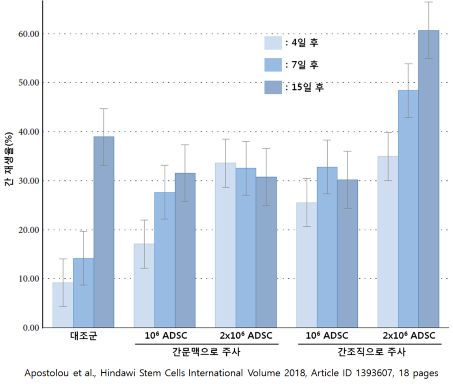
Additionally, ADSCs may play a role in protecting normal cells by preventing apoptosis. The anti-apoptotic effect of ADSCs can be used to treat liver disease. Ge et al. showed in an ischemia-reperfusion experiment using miniature pigs that the rate of apoptosis in resected livers injected with ADSCs was reduced compared to resected livers not injected with ADSCs (Ge et al. Scientific report, (2018) 8:16878 ). In other words, when ADSCs were injected into resected hepatocytes and then reperfused, the rate of apoptosis decreased compared to when ADSCs were not injected.
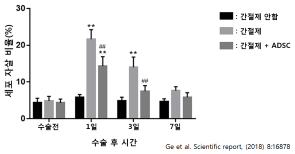
Finally, when ADSCs coexist with liver cancer cells, they can promote apoptosis and inhibit proliferation and migration of cancer cells. Serhal R et al. cultured liver cancer cell lines, HepG2 and PLC-PRF-5, with ADSC and measured the proliferation and apoptosis of the liver cancer cell lines 48 hours later (Serhal R et al. World J Gastroenterol 2019 February 7;25-5:567-583).
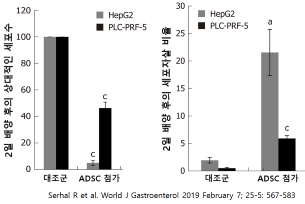
These results show that the addition of ADSC decreased the proliferation of liver cancer cell lines and increased apoptosis. Serhal R et al. in an additional study showed that ADSC promotes the expression of cancer suppressor genes such as p53 in liver cancer cells and suppresses the expression of cancer promotion genes such as c-Myc, increasing the apoptosis rate of liver cancer cells and increasing the apoptosis rate of liver cancer cells. It was suggested that the proliferation of could be suppressed. The anti-cancer effect of ADSC appears to be synergistic when combined with radiation therapy. Wu et al. combined irradiation of radiation and intravenous injection of ADSC into liver cancer reproduced in nude mice and observed changes in the size of liver cancer for 15 days (Wu et al., Frontiers in Cell and Developmental Biology, November 2019, Volume 7, Article 267).
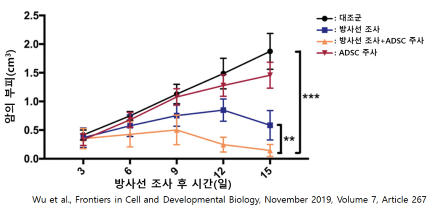
These results show that the size of liver cancer was reduced the most when radiation irradiation and ADSC injection were combined.
3. What liver diseases does ADSC help treat?
Clinical results show that it is effective in treating alcoholic cirrhosis, and animal testing results show that it is likely to be effective in treating non-alcoholic fatty liver disease and liver cancer. Let us briefly look at the effectiveness of ADSC in the treatment of alcoholic cirrhosis. Gotze et al. intravenously injected cultured ADSCs into three patients with alcoholic cirrhosis (Gotze et al., Clinical and Translational Gastroenterology 2019;10:e00095). As shown in the table, all three patients were at a stage where treatment other than liver transplantation could not be considered.

Gotze et al. performed six intravenous ADSC injections in patient 1, four times and two times in patients 2 and 3, respectively.
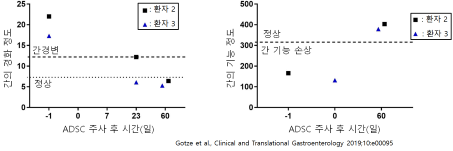
As shown in the results, patients 2 and 3 returned to normal around 60 days after injection. Patient 1, who had the most severe cirrhosis from the beginning, showed normal liver values after a longer period of time (88 days) than the other patients and showed a stable condition thereafter. From the above results, it can be seen that intravenous injection of ADSC is effective in treating severe cirrhosis.
If this video helped resolve your questions about the treatment of liver disease with adipose-derived stem cells (ADSC),
Liver diseases include non-alcoholic fatty liver disease, alcoholic fatty liver disease, acute hepatitis, chronic hepatitis, cirrhosis, and liver cancer. If I were to add one more thing, there would be Gandystoma. Both acute hepatitis and chronic hepatitis are viral diseases caused by hepatitis A, B, and C viruses, and the standard for distinguishing the two is 6 months. In other words, if hepatitis lasts for more than 6 months, it is classified as chronic hepatitis. Gandystoma occurs when you are infected with liver fluke, and it is a disease that can be avoided if you do not consume freshwater fish, which is an intermediate host for liver fluke, raw. As the name suggests, alcoholic fatty liver disease is a disease in which fat accumulates in liver cells due to continued excessive drinking, resulting in decreased liver function, whereas non-alcoholic fatty liver disease is caused by a high-fat diet, genetic factors, oxidative stress, excessive cytokines, and fatty liver disease. It is known to be caused by inflammatory reactions caused by the production of prokines, excessive expression of toll-like receptors, and LPS, and is characterized by liver inflammation and fibrosis. Cirrhosis, also called liver fibrosis, is a disease in which liver cells are extensively destroyed, fibrous tissue proliferates, and liver function is lost. Chronic hepatitis, alcoholic fatty liver disease, and non-alcoholic fatty liver disease can easily develop into cirrhosis if not cured. Liver cancer is the cancer with the fourth highest mortality rate, and 782,000 people died from liver cancer in 2018 alone. Liver cancer is caused by the conversion of liver cells into cancer cells. It can metastasize early in development and easily infiltrate multiple tissues, making it a fatal cancer with a very low 5-year survival rate. When surgery and liver transplantation are not possible, radiation therapy is mainly used. Even if high doses of radiation are applied to the exact location, cancer cells do not die immediately, so recurrence and metastasis of liver cancer are quite common, making liver cancer difficult to cure. Liver cirrhosis has a tendency to develop into liver cancer.

2. What functions of ADSCs can help treat liver disease?
As mentioned in the previous video, ADSCs have abilities such as promoting angiogenesis, secreting growth factors, regulating immunity, and differentiating into other cells. This ability of ADSCs will contribute to promoting hepatocyte regeneration. Apostolou et al. removed the livers of mice and injected ADSCs into the portal vein or liver tissue (Apostolou et al., Hindawi Stem Cells International Volume 2018, Article ID 1393607, 18 pages). The mice were killed on the 4th, 7th, and 15th days after injection, and the weight of the liver was measured. The 4- or 7-day-old mice injected with ADSC showed a regenerative effect that was more than twice that of the control group that was not injected with ADSC. The effect increased proportionally to the injection amount of ADSC. Additionally, the liver regeneration effect was more evident when injected directly into the liver tissue than when injected into the portal vein.

Additionally, ADSCs may play a role in protecting normal cells by preventing apoptosis. The anti-apoptotic effect of ADSCs can be used to treat liver disease. Ge et al. showed in an ischemia-reperfusion experiment using miniature pigs that the rate of apoptosis in resected livers injected with ADSCs was reduced compared to resected livers not injected with ADSCs (Ge et al. Scientific report, (2018) 8:16878 ). In other words, when ADSCs were injected into resected hepatocytes and then reperfused, the rate of apoptosis decreased compared to when ADSCs were not injected.

Finally, when ADSCs coexist with liver cancer cells, they can promote apoptosis and inhibit proliferation and migration of cancer cells. Serhal R et al. cultured liver cancer cell lines, HepG2 and PLC-PRF-5, with ADSC and measured the proliferation and apoptosis of the liver cancer cell lines 48 hours later (Serhal R et al. World J Gastroenterol 2019 February 7;25-5:567-583).

These results show that the addition of ADSC decreased the proliferation of liver cancer cell lines and increased apoptosis. Serhal R et al. in an additional study showed that ADSC promotes the expression of cancer suppressor genes such as p53 in liver cancer cells and suppresses the expression of cancer promotion genes such as c-Myc, increasing the apoptosis rate of liver cancer cells and increasing the apoptosis rate of liver cancer cells. It was suggested that the proliferation of could be suppressed. The anti-cancer effect of ADSC appears to be synergistic when combined with radiation therapy. Wu et al. combined irradiation of radiation and intravenous injection of ADSC into liver cancer reproduced in nude mice and observed changes in the size of liver cancer for 15 days (Wu et al., Frontiers in Cell and Developmental Biology, November 2019, Volume 7, Article 267).

These results show that the size of liver cancer was reduced the most when radiation irradiation and ADSC injection were combined.
3. What liver diseases does ADSC help treat?
Clinical results show that it is effective in treating alcoholic cirrhosis, and animal testing results show that it is likely to be effective in treating non-alcoholic fatty liver disease and liver cancer. Let us briefly look at the effectiveness of ADSC in the treatment of alcoholic cirrhosis. Gotze et al. intravenously injected cultured ADSCs into three patients with alcoholic cirrhosis (Gotze et al., Clinical and Translational Gastroenterology 2019;10:e00095). As shown in the table, all three patients were at a stage where treatment other than liver transplantation could not be considered.

Gotze et al. performed six intravenous ADSC injections in patient 1, four times and two times in patients 2 and 3, respectively.

As shown in the results, patients 2 and 3 returned to normal around 60 days after injection. Patient 1, who had the most severe cirrhosis from the beginning, showed normal liver values after a longer period of time (88 days) than the other patients and showed a stable condition thereafter. From the above results, it can be seen that intravenous injection of ADSC is effective in treating severe cirrhosis.
If this video helped resolve your questions about the treatment of liver disease with adipose-derived stem cells (ADSC),
- PrevArthritis treatment using adipose stem cells 24.04.16
- NextAnti-inflammatory effect of ADSC 24.04.16
댓글목록
등록된 댓글이 없습니다.






 +82-2-532-2856
+82-2-532-2856 info@panacellbio.com
info@panacellbio.com 521, Teheran-ro, Gangnam-gu, Seoul, Republic of Korea
521, Teheran-ro, Gangnam-gu, Seoul, Republic of Korea